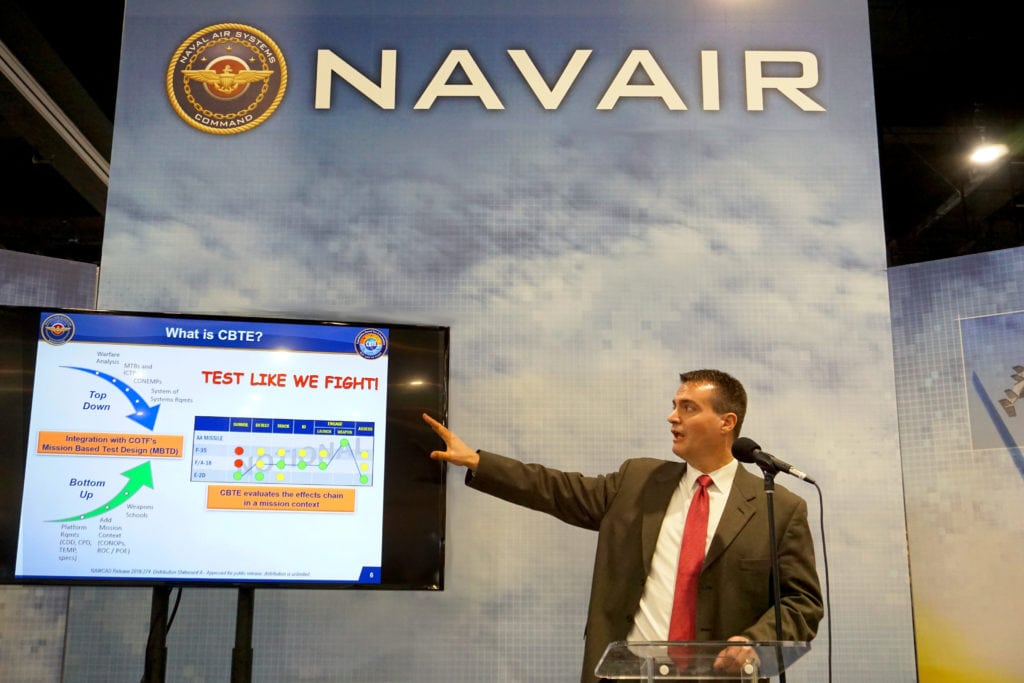
Ken Senechal spoke about the importance of mission-based platform testing at Sea-Air-Space.
It makes sense to pay a nickel up front to save a dime in the long run. It’s easier to commit to that when a nickel is five cents instead of millions of dollars, of course, but the principle holds.
To accomplish that, the U.S. Navy is doing something it has been talking about for a decade, according to Ken Senechal, capabilities-based test and evaluation director for the Naval Air Warcraft Center (NAWC). In his words, the Navy is “testing how they fight.”
The idea, Senechal said during the annual Sea-Air-Space exposition, is that simply testing a new head-up display (HUD) targeting system for the MH-60 Black Hawk by firing missiles to make sure it works mechanically before approving it and sending it on to be used, where it might be found lacking in efficacy, is inefficient. It makes more sense to test its functionality in mission-based exercises that mimic use cases for the targeting system so weaknesses are discovered early in the process when alterations are faster and cheaper.
Ensuring that test pilots have the resources and expertise necessary to complete those tasks has a cost in time and money, as does making sure that Senechal’s division is able to effectively plan test missions for them. But that’s the nickel that he says will save the military a dime in the long run.

Sample assessments involving multiple assets. (Photo by Avionics)
That way, ultimately, the test center delivers a working targeting system with a report on how it performs in different situations along with suggested tactics. In the real case of the MH-60 HUD, testers were even the instructors for the fleet squadron. Senechal said skipping all that work, which normally needs to be done once a piece of equipment gets to that point in the development cycle, more than pays for the front-end investment, particularly because speed-to-fleet is the top priority for the Navy right now.
One project is currently six months ahead of schedule because of the mission-based testing, according to Senechal.
To accomplish the reordering of testing priorities, NAWC is working with the more experienced commander of the operational test and evaluation force to learn and adopt best practices. Among those, top-down test design — in which reverse engineering warfare analysis leads to mission-technical baselines (opposition capability analysis) and integrated capabilities-technical baselines (what the U.S. needs to do) — is mixed with bottom-up test design, which sees general mission context layered over equipment specifications and evaluations, to develop a relevant test for how a piece of equipment will be used.
Senechal stressed the importance basing tests on “understanding how and where we’re actually going to go fly this aircraft.” He added, “I’m not going to fly the aircraft this way, why do I need to test it this way?” pointing out that there may not be any reason to spend time gathering data points that have traditionally been gathered if they would never be relevant to an aircraft’s field use.

A chart showing platform capability evaluations.
To that end, his division charts the various capabilities of aircraft from mission-capable (green) to incapable or not applicable (red) and make sure they spend the most time testing the functionality and best way to use the greens.
Designing tests that mimic missions requires specialized test mission parameters and often integrated testing in which one test sortie involves multiple platforms. Because of the connected, networked nature of warfare today, Senechal said this is necessary for effective evaluation. It also allows NAWC to better understand how different aircraft and pieces of equipment complement each other and provide strong use recommendations when delivering approved items.